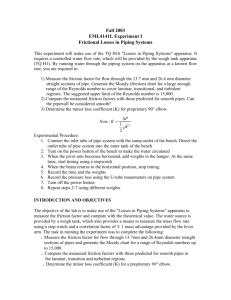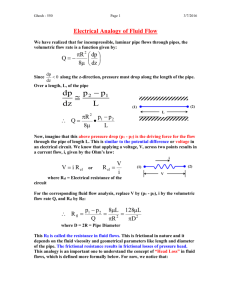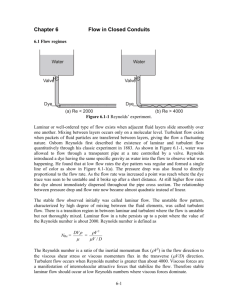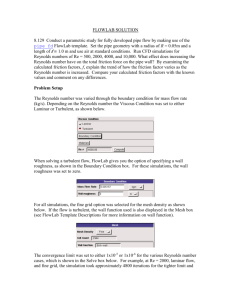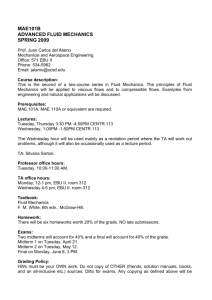Laminar and turbulent flow
advertisement
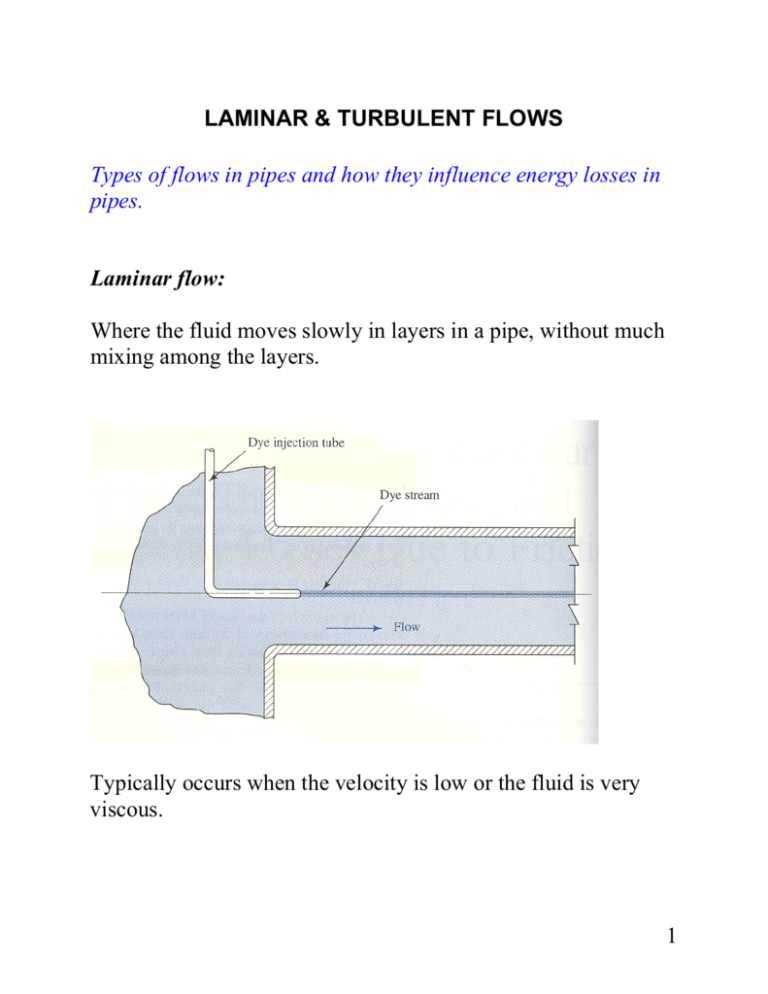
LAMINAR & TURBULENT FLOWS Types of flows in pipes and how they influence energy losses in pipes. Laminar flow: Where the fluid moves slowly in layers in a pipe, without much mixing among the layers. Typically occurs when the velocity is low or the fluid is very viscous. 1 2 Turbulent flow Opposite of laminar, where considerable mixing occurs, velocities are high. Laminar and Turbulent flows can be characterized and quantified using Reynolds Number established by Osborne Reynolds and is given as – 3 NR = V Dρ η = VD ν Where NR – Reynolds number V – velocity of flow (m/s) D – diameter of pipe (m) ρ – density of water (kg/m3) ή – dynamic viscosity (kg/m.s) ν – kinematic viscosity (m2/s) when – units are considered – NR is dimensionless. NOTE – Reynolds number directly proportional to velocity & inversely proportional to viscosity! NR < 2000 – laminar flow NR > 4000 – Turbulent flow 4 For 2000 < NR < 4000 – transition region or critical region – flow can either be laminar of turbulent – difficult to pin down exactly. More viscous fluid will tend to have laminar flow or lower Reynolds number. Reynolds numbers for some real-life examples – • Blood flow in brain ~ 100 • Blood flow in aorta ~ 1000 • Typical pitch in major league baseball ~ 200000 • Blue whale swimming ~ 300000000 5 Problem 8.1: Determine the Reynolds number for – Glycerin at 25C Pipe at D = 150 mm = 0.15 m Velocity = V = 3.6 m/s ρ = 1258 kg/m3 ή = 0.96 Pa.s or (kg/m.s) NR = V Dρ η = 3.6 * 0.15 * 1258 / 0.96 = 708 Nr < 2000; therefore flow is laminar! 6 Friction losses in Pipes Vary with laminar or turbulent flow Energy equation can be given as – p1/γ + z1 + v12/2g + hA – hR – hL = p2/γ + z2 + v22/2g where hA, hR, hL are the heads associated with addition, removal and friction loss in pipes, respectively. note that the terms are added on the LHS of the equation! The head loss in pipes = hL can be expressed as – hL = f * (L/D) * v2/2g - Darcy’s equation for energy loss (GENERAL FORM) Where f – friction factor L – length of pipe D – diameter of pipe v – velocity of flow How do these factors affect losses??????????? 7 Similarly, Another equation was developed to compute hL under Laminar flow conditions only hL 32 η L V = γ D2 - called the Hagen-Poiseuille equation If you equate Darcy’s equation and Hagen-Poiseuille equation Then we can find the friction factor f 64η 64 f = = V D ρ NR Thus the friction factor is a function of Reynold’s number! 8 Example Problem 8.4 Determine energy loss if – Glycerin at 25C L = 30m D = 150 mm = 0.15 m V = 4.0 m/s Density = 1258 k/m3 Dynamic viscosity = 0.96 Pa.s First determine the Reynolds number to determine if it is laminar flow NR = V Dρ η = 4.0 * 0.15 * 1258 / 0.96 = 786 < 2000 - Laminar flow Therefore Darcy’s equation hL = f * (L/D) * (v2/2g) = 64/NR * (L/D) * (v2/2g) = 13.2 m 9 Friction losses for Turbulent Flow For Laminar flow we got a nice equation to compute the friction factor – dependent ONLY on Reynolds number! In case of Turbulent flow – friction factor computed based on inside roughness of the pipe and Reynolds number! Roughness is expressed as - Relative roughness = D/ε (not the best way to express it!) • More rough pipe – low D/ε • Less rough pipe – high D/ε Friction factor for Turbulent flow ~ Relative roughness & Reynolds number Roughness values for various pipes – Table 8.2 10 Some Roughness values from Table 8.2 Material Plastic Steel Galvanized iron Concrete Roughness ε (m) 3.0 x 10-7 4.6 x 10-5 1.5 x 10-4 1.2 x 10-4 Question - **Why doesn’t ε affect loss in laminar flow conditions ????????? 11 The Moody Diagram Developed to provide the friction factor for turbulent flow for various values of Relative roughness and Reynold’s number! Curves generated by experimental data. 12 Key points about the Moody Diagram – 1. In the laminar zone – f decreases as Nr increases! 2. f = 64/Nr. 3. transition zone – uncertainty – not possible to predict 4. Beyond 4000, for a given Nr, as the relative roughness term D/ε increases (less rough), friction factor decreases 5. For given relative roughness, friction factor decreases with increasing Reynolds number till the zone of complete turbulence 6. Within the zone of complete turbulence – Reynolds number has no affect. 7. As relative roughness increases (less rough) – the boundary of the zone of complete turbulence shifts (increases) If you know the – relative roughness, Reynolds number – you can compute the friction factor from the Moody Diagram 13 14 Swamee and Jain converted the graph into an equation! For the turbulent portion (less than 1% error) f = 0.25 2 ⎡ ⎛ ⎞ 5.74 ⎤ 1 ⎟⎟ + 0.9 ⎥ ⎢ log ⎜⎜ 3 . 7 ( / ) ε D ⎢⎣ ⎝ ⎠ N R ⎥⎦ 15 Example problem 8.5: Determine friction factor if water at 160 F is flowing at 30 ft/s in an uncoated ductile iron pipe having an inside diameter of 1.0 inch. Determine Reynolds number: NR = V Dρ η = VD ν D = 1/12 = 0.0833 ft; V = 30 ft/s; ν = 4.38 x 10-6 ft2/s NR = 5.70 x 105 So its turbulent flow, we will have to use Moody diagram Determine relative roughness – ε for ductile iron pipe from table 8.2 in text = 8 x 10-4 ft D/ ε = 0.0833/8 x 10-4 = 104, use 100 for moody diagram Using those values and going into Moody’s diagram, we get – 16 f = 0.0038. 17 Hazen-William formula Alternate formula to compute head loss due to friction Applicable for – - Water - D – larger than 2 inches and less than 6ft - Velocity should not exceed 10 ft/s The formula is unit-specific For SI units – ⎡ ⎤ Q hL = L ⎢ 0.63 ⎥ A C R 0 . 85 h ⎣ ⎦ 1.852 Where Q = 0.85 A C h R 0.63 s 0.54 Where R – hydraulic radius = area/perimeter of pipe. Ch – Hazen Williams Coefficient and s – slope gradient of the pipe. 18 Head Additions and Losses due to Pumps and Motors (CHAPTER 7) Bernoulli’s Energy equation can be given as – p1/γ + z1 + v12/2g + hA – hR – hL = p2/γ + z2 + v22/2g where hA, hR, hL are the heads associated with addition, removal and friction loss in pipes, respectively. also known as the GENERAL ENERGY EQUATION represents the system in reality (not idealized conditions) 19 hA – head/energy additions due to pumps. hR – head/energy removal due to motors. hL – head losses due to friction and losses due to fittings, bends, valves. MAJOR LOSSES – motors, friction loss MINOR LOSSES – valves, fittings, and bends Typically hL = K * v2/2g that’s what we saw before with respect to Darcy’s Equation. 20 Example Problem 7.1: Finding TOTAL head loss due to friction, valves, bends etc. – Given – Water moving in the system Q = 1.20 ft3/s Calculate TOTAL head loss due to valves, bends, and pipe friction. How should we proceed??????????? 21 Apply the General Energy Equation for pts 1 and 2! p1/γ + z1 + v12/2g - hL = p2/γ + z2 + v22/2g cancel out the terms – p1/γ + z1 + v12/2g - hL = p2/γ + z2 + v22/2g and we get – hL = (z1- z2) - v22/2g (z1- z2) = 25 ft How do we find v2??? Area of 3 inch dia pipe = 0.0491 ft2 v2 = 1.20 / 0.0491 = 24.4 ft/s hL = 25 – (24.4)2/2*32.2 = 15.75 ft 22 Example Problem 7.2: - Now we will introduce a Pump and determine the energy added by a pump! • Q = 0.014 m3/s • Fluid – Oil at Sg = 0.86; γ = 0.86 * 9.81 = 8.44 kN/m3 • hL = head loss due to friction, fittings, etc. = 1.86 Nm/N Energy added by Pump???????????????????? 23 Apply the General Energy Equation for pts. A and B! pA/γ + zA + vA2/2g + hA - hL = pB/γ + zB + vB2/2g Rearrange the equation! hA = hL + (pB – pA) / γ + (zB – zA) + (vB2 - vA2 ) / 2g (pB – pA) / γ = (296-(-28))/8.44 = 38.4 m (zB – zA) = 1.0 m How will you find velocities????? Area at A = 0.004768 m2 Area at B = 0.002168 m2 vA = 2.94 m/s vB = 6.46 m/s plug all terms back in the original equation – hA = hL + (pB – pA) / γ + (zB – zA) + (vB2 - vA2 ) / 2g 24 and hA = 1.86 + 38.4 + 1.0 + 1.69 = 42.9 m or 42.9 N.m/N 25 Power supplied by Pumps Power of the pump = energy being transferred PA = hA * W (where W is the weight flow rate) = hA * γ *Q SI units of power = watt (W) = 1.0 N.m/N or 1.0 Joule US units of Power = lb-ft/s 1 horsepower = 1 hp = 550 lb-ft/s 1 hp = 745.7 Watt Efficiency of the Pump = (Power delivered to the fluid/ Power supplied to the pump) = (PA/PI) 26 Example Problem 7.3: Determine the efficiency of the Pump PI = 3.85 hp Q = 500 gal/min of oil = 1.11 ft3/s γ of oil = 56.0 lb/ft3 What is PA???? And what is efficiency (em) ???? So how do you proceed???????????????????? 27 Apply the General Energy Equation for pts 1 and 2! p1/γ + z1 + v12/2g + hA = p2/γ + z2 + v22/2g Rearrange the equation! hA = (p2 – p1) / γ + (z2 – z1) + (v22 - v12 ) / 2g let’s solve for each term γm = 13.54*62.4 = 844.9 lb/ft3 pressure difference using the manometer – p1 + γo y + 20.4*γm – 20.4*γo - γo y = p2 (p2 – p1) / γo = (γm*20.4 / γo) – 20.4 = (844/56 -1) * 20.4 = 24.0 ft Elevation difference is zero! Find out the velocity head term??? 28 A1 = 0.2006 ft2 A2 = 0.0884 ft2 V1 = 5.55 ft/s V2 = 12.6 ft/s (v22 - v12 ) / 2g = 1.99 ft Substituting the terms – hA = (p2 – p1) / γ + (z2 – z1) + (v22 - v12 ) / 2g hA = 24.0 + 0 + 1.99 = 25.99 ft PA = hA * γo *Q = 25.99 * 56.0 * 1.11 = 1620 lb-ft/s = 1620/550 = 2.95 hp em = 2.95/3.85 = 0.77 We have the answer! 29 Similarly, Power delivered to motors PR = hR * γ *Q Efficiency of the motor = (Power output/ Power delivered by fluid) = (PO/PR) ASSIGNMENT # 6 1. 7.7M 2. 7.13M 3. 8.1E 4. 8.33E 30

